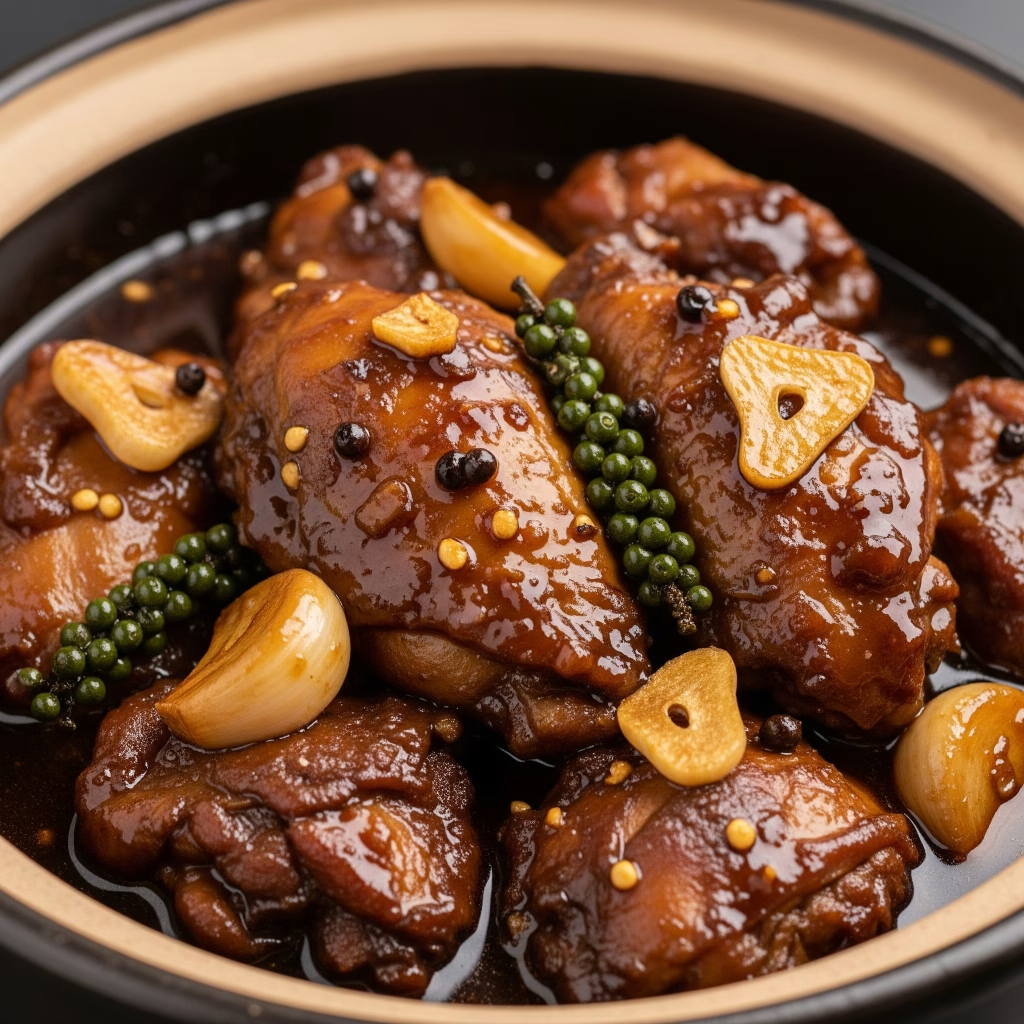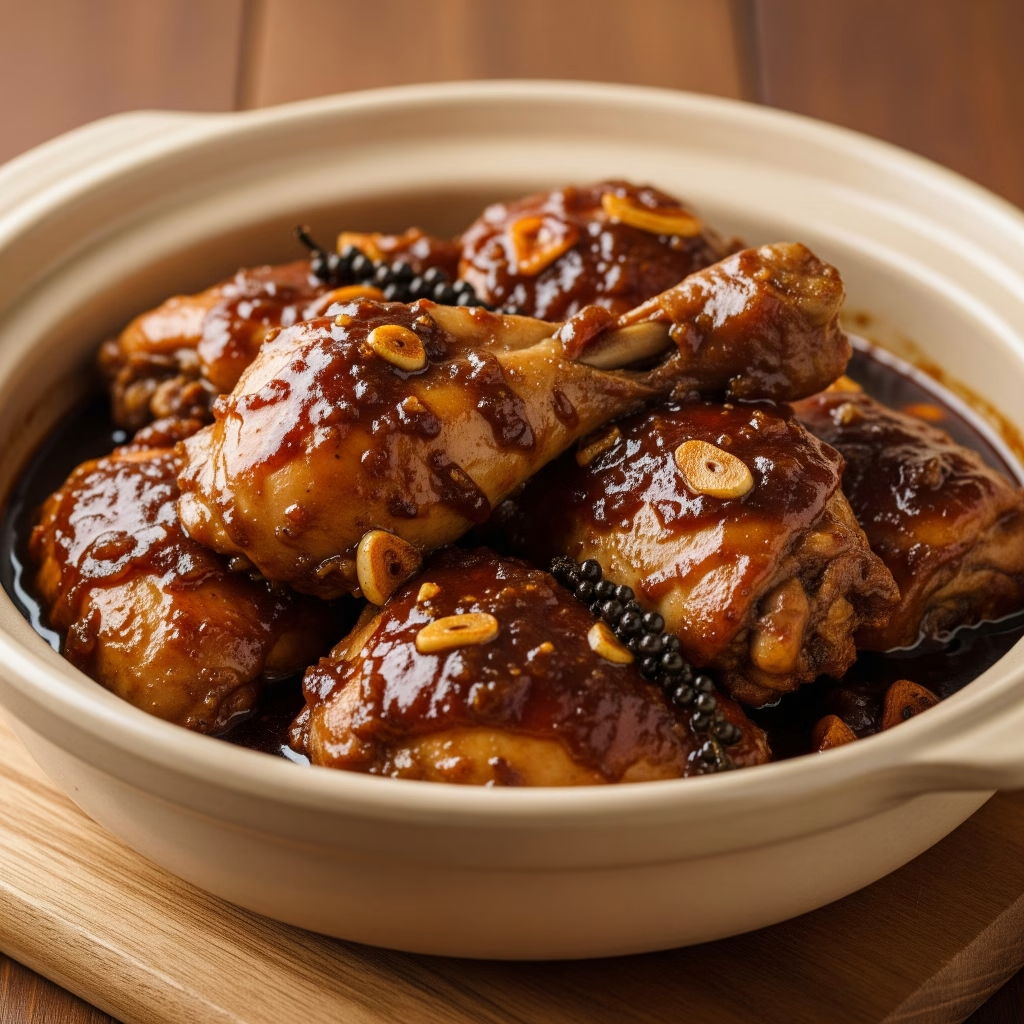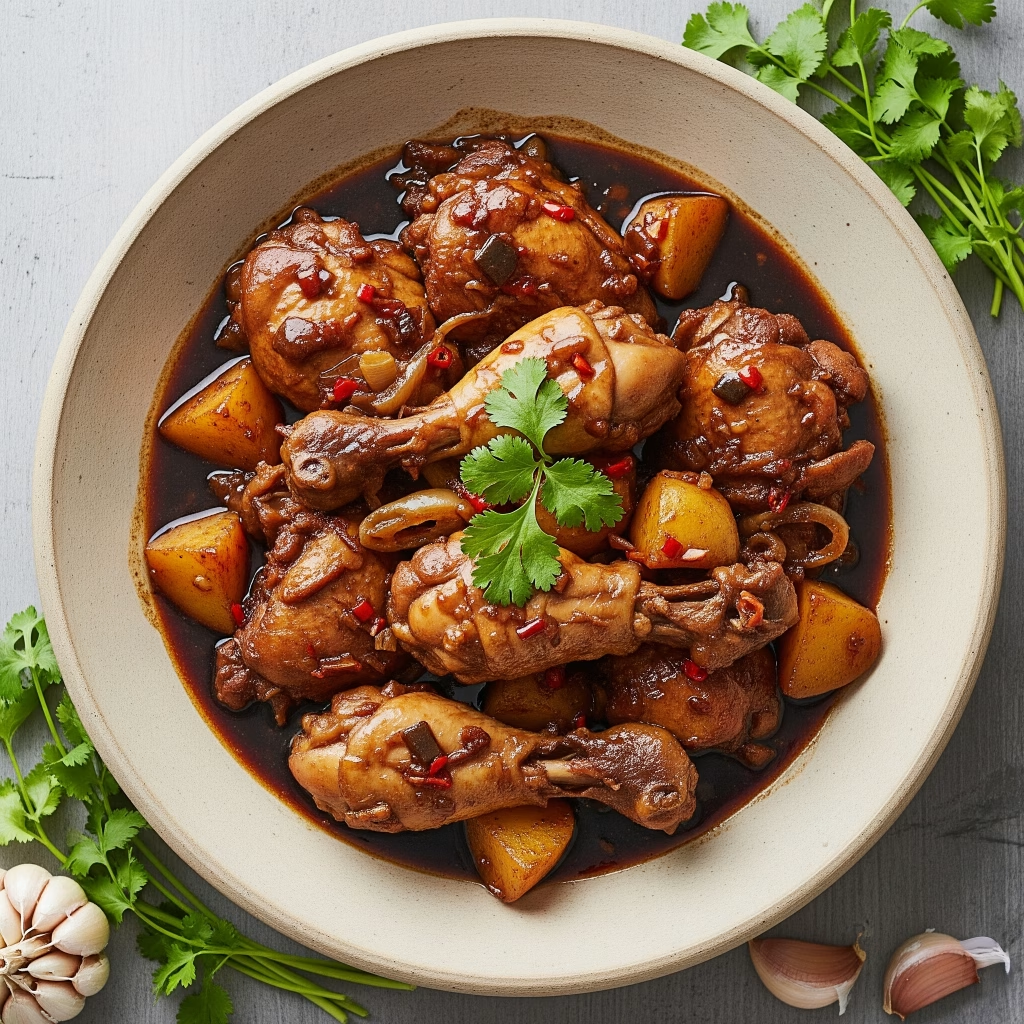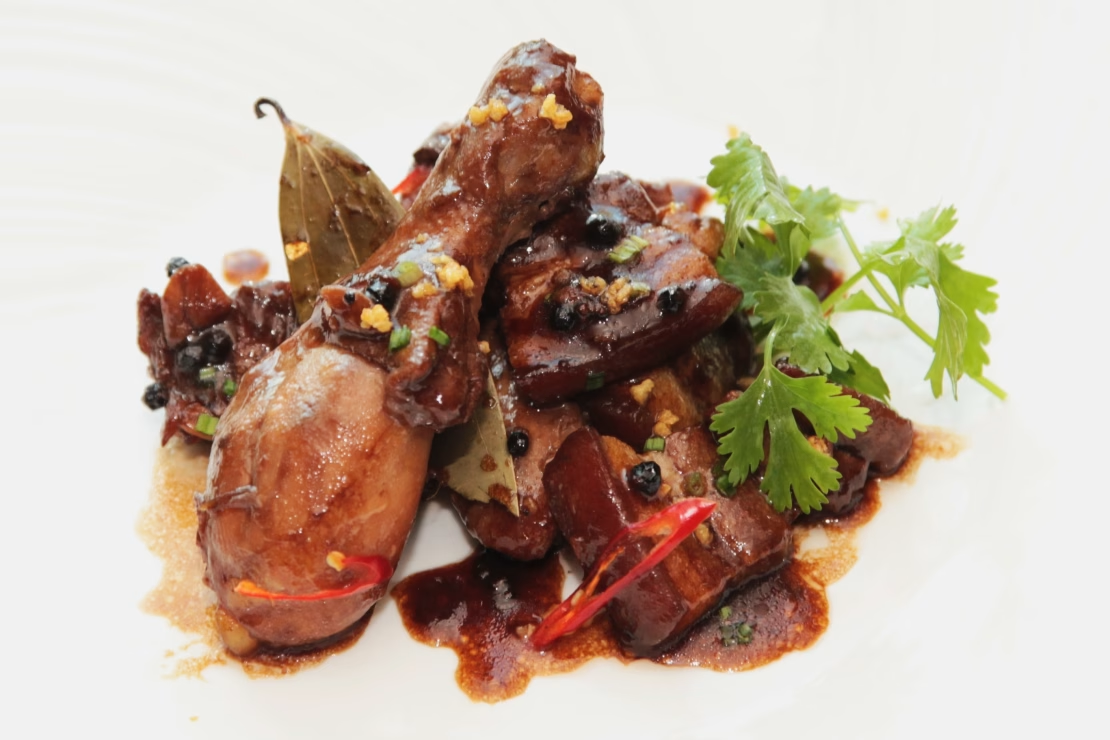Filipino Chicken Adobo is the ultimate comfort food of the Philippines—a bold, savory, and tangy braised chicken dish that balances soy sauce, vinegar, garlic, bay leaves, and black peppercorns in a rich, mouthwatering sauce.
Often considered the unofficial national dish of the Philippines, Chicken Adobo is as deeply cultural as it is delicious. With its minimal ingredients and deeply satisfying flavors, it’s no surprise that this dish is a staple in every Filipino home. Whether served at family gatherings, everyday lunches, or festive feasts, Chicken Adobo represents the heart of Filipino cuisine: simple, soulful, and unmistakably flavorful.
Table of Contents
Ingredients
For the Chicken and Marinade:
- 1 kg (2.2 lbs) bone-in, skin-on chicken thighs and drumsticks
- ½ cup soy sauce
- ½ cup cane vinegar (or white vinegar)
- 1 cup water
- 6 garlic cloves, smashed
- 2 bay leaves
- 1 tsp whole black peppercorns
- 1 tbsp brown sugar (optional, for a touch of sweetness)
- 1 small onion, sliced (optional but adds depth)
For Cooking:
- 2 tbsp cooking oil
- Additional water as needed
- Extra chopped garlic for sautéing (optional)
Serves
Serves: 4–5 people
Prep Time: 10 minutes
Marinating Time: 30 minutes to overnight
Cooking Time: 45 minutes
Total Time: 1 hour 30 minutes (including marination)
Step-by-Step Instructions
Step 1: Marinate the Chicken
- In a large bowl or zip-lock bag, combine the chicken with soy sauce, vinegar, smashed garlic, bay leaves, peppercorns, and sugar.
- Mix well and let marinate in the refrigerator for at least 30 minutes. For best flavor, marinate overnight.
Step 2: Brown the Chicken
- Heat the cooking oil in a deep skillet or Dutch oven over medium heat.
- Remove chicken from marinade (reserve the liquid) and brown on both sides, about 3–4 minutes per side. This step adds extra depth and richness.
Step 3: Simmer the Adobo
- Once the chicken is browned, add the reserved marinade back to the pot along with 1 cup of water and onion (if using).
- Bring to a boil, then reduce the heat to low, cover, and simmer for 30–40 minutes, or until the chicken is tender and infused with flavor.
- Optional: Uncover and let the sauce reduce to your desired thickness, spooning it over the chicken as it simmers.
Step 4: Taste and Adjust
- If it’s too salty, add a bit more water.
- If it’s too tangy, balance with a pinch more sugar.
- For extra garlic punch, sauté chopped garlic in oil and add toward the end.

Serving Suggestions
- With Steamed White Rice: The classic and most beloved pairing.
- Over Garlic Fried Rice: Known as Adobo Fried Rice for breakfast or leftovers.
- Side Dishes: Serve with sautéed greens like kangkong (water spinach), bok choy, or steamed vegetables.
- Pickled Vegetables (Atchara): A sweet Filipino pickle made with papaya adds contrast.
Tips for Perfect Chicken Adobo
- Use Bone-In Chicken: Adds richness and depth to the broth-like sauce.
- Marinate Overnight: This intensifies the savory-sour profile.
- Don’t Stir the Vinegar Initially: Let it cook down for a few minutes first to mellow the acidity.
- Reduce Sauce Slowly: Let it thicken naturally—don’t rush.
- Double Garlic? Yes Please: Some families even use a full head of garlic for extra flavor.
Healthier Alternatives
- Skinless Chicken or Chicken Breast: Lower fat version, though less flavorful.
- Low-Sodium Soy Sauce: Helps reduce overall salt content.
- No Sugar Version: Traditional adobo doesn’t include sugar—feel free to omit.
- Air Fry or Bake the Chicken First: Less oil needed than pan-searing.
- Serve with Brown Rice or Quinoa: For a whole-grain side.
Creative Variations
- Adobong Puti (White Adobo): Made without soy sauce, using only vinegar and garlic.
- Adobo sa Gata: Add coconut milk for a creamy, Southern Philippine twist.
- Spicy Adobo: Add chili flakes or siling labuyo (bird’s eye chili) for heat.
- Pork or Tofu Adobo: Swap out chicken for pork belly or firm tofu.
- Adobo Flakes: Shred leftover chicken and fry until crispy—perfect for breakfast.

Common Mistakes to Avoid
- Skipping the Marination: It’s crucial for depth of flavor.
- Using the Wrong Vinegar: Use cane, palm, or white vinegar. Balsamic or apple cider changes the dish entirely.
- Too Much Stirring: Stirring too early with vinegar can make the dish bitter.
- Overcrowding the Pan When Searing: Do it in batches if necessary for proper browning.
- Reducing Too Fast: Don’t boil on high—low and slow gives the best sauce texture.
History of Filipino Chicken Adobo
1. Pre-Colonial Beginnings
Adobo as a cooking technique predates Spanish colonization. Indigenous Filipinos were already preserving meat by stewing it in vinegar and salt to prevent spoilage in the tropical climate. This vinegar-based braising method ensured food could last for days without refrigeration. Garlic and peppercorns were locally available and were natural additions to the early version of the dish.

2. Spanish Influence on Ingredients and Name
When the Spanish colonizers arrived in the 16th century, they observed this vinegar-braising method and named it “adobo” after the Spanish word “adobar,” meaning “to marinate.” Though the name stuck, Filipino adobo evolved separately from its Spanish counterpart. Over time, soy sauce was introduced (possibly via Chinese trade), and this addition turned the dish into the dark, savory-sour delight that is loved today.
3. A National Symbol in Every Household
Today, Adobo is considered the unofficial national dish of the Philippines, precisely because of its simplicity, adaptability, and popularity. Every Filipino family has its own take—some prefer it dry and caramelized, others soupy and tangy. Its flexibility and humble ingredients reflect the Filipino people’s creativity and resourcefulness. Beyond borders, Adobo has gained international fame as part of Filipino diaspora cuisine, celebrated in cookbooks, YouTube channels, and high-end restaurants alike.
FAQs About Filipino Chicken Adobo
1. What does “Adobo” mean in the Philippines?
In Filipino cuisine, adobo refers to a cooking method using vinegar, soy sauce, garlic, and spices—not to be confused with the Spanish or Mexican adobo sauces.
2. Can I make Adobo with other meats?
Absolutely! Pork is very common, and some versions use beef, tofu, or even squid (adobong pusit).
3. How long does Adobo last?
It can last up to 5 days refrigerated and tastes better after a day or two as flavors deepen.
4. Can Adobo be frozen?
Yes. Store in freezer-safe containers for up to 2–3 months.
5. Is sugar traditionally used in Adobo?
Traditionalists often skip sugar, but some families add a bit for balance—especially in Luzon.
6. What type of vinegar is best?
Cane vinegar is traditional, but white vinegar is an acceptable substitute. Avoid sweet vinegars like balsamic.
7. Can I make Adobo in a slow cooker?
Yes. Cook on low for 6–7 hours after browning the chicken.
8. Why does my Adobo taste too salty or sour?
You may need to balance with more water, a pinch of sugar, or a bit of onion to mellow the acidity.
9. Do I need to use whole peppercorns?
Whole peppercorns are traditional and give a mild heat. You can use ground pepper but start with less.
10. Can I add vegetables to Adobo?
Some versions include potatoes or hard-boiled eggs. Greens like spinach can also be added at the end.
Filipino Chicken Adobo isn’t just a recipe—it’s a cultural institution. It’s hearty, easy to prepare, incredibly flavorful, and infinitely customizable. From its humble pre-colonial roots to its status as a national treasure, Chicken Adobo showcases the beauty of simple ingredients transformed through tradition, patience, and passion. Whether you’re Filipino or simply a curious food lover, mastering this dish opens the door to one of Southeast Asia’s most vibrant culinary traditions. Serve it with rice, share it with friends or family, and let the bold tangy aroma fill your kitchen with the soul of the Philippines.


